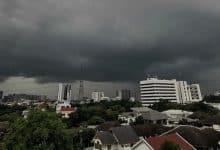Navigating Thailand’s weather conditions: From mild winter to sweltering heat

Associate Professor Dr Seree Suparathit, the Director of the Center for Climate Change and Disasters at Rangsit University and Vice President at the National Disaster Warning Council Foundation, recently shared insights on the upcoming weather conditions in Thailand. Dr Seree’s Facebook post highlighted that while the end of the year in Thailand is not expected to be cold, the following year is anticipated to be extremely hot and dry.
Despite recent rains after the rainy season, especially in the southern region, there was no significant flooding, and any inundation is generally expected to recede as part of the natural drainage process. Unusually, this year’s rainfall forecasts, including models related to the El Niño phenomenon, have indicated a trend towards less rain.
However, it is worth noting that the amount of rainfall in September and October surpassed typical levels by approximately 30% and 19%, respectively, particularly in the northern and northeastern regions. Nonetheless, these accumulations still fall short of the normal annual average, except in the northeastern region. Therefore, this year’s rain predictions remain subject to fluctuations and may require monthly monitoring by farmers and agricultural communities.
While September and October may bring heavy rainfall and localized flooding, an analysis using the Standardized Precipitation-Evapotranspiration Index (SPEI) shows that many areas, particularly in the central and eastern regions, still grapple with drought conditions over the past 3 to 6 months. This dry spell is most prevalent, except for the western and northeastern regions along the Mekong River.
Dr Seree’s examination of temperature distributions from December to April in the years 2020 to 2024 revealed that December’s temperatures are expected to be lower than average each year, signifying cooler weather. However, an exception is forecasted for this year, where temperatures could increase by nearly 2 degrees Celsius, suggesting a milder winter.
In contrast, the average temperature for April next year is projected to be 1.5 degrees Celsius higher than usual, indicating an exceptionally hot period. These temperature shifts are attributed to climate change (global warming) and unpredictable weather conditions, notably El Niño.

The onset of the second rice farming season is marked by available water resources due to recent rainfall. Favourable rice prices are motivating farmers in many areas to cultivate rice crops. Nonetheless, it’s essential to consider that the Chao Phraya Basin’s water supply for this year stands at around 62% (approximately 2,300 million cubic metres) less than last year’s allocation. Last year, over 78% (approximately 14,000 million cubic metres) was allocated.
This stark reduction could result in a reduction of the rice farming area from 8 million rai to no more than 2 million rai. This may pose a considerable challenge, particularly in areas outside the irrigation network, which comprises over 80% of the northeastern region.
The combination of insufficient water resources, the anticipated drought, and heightened evaporation rates could lead to adverse consequences, including increased forest fires in the northern region, elevated PM2.5 dust levels, and heat waves in urban areas.
While seasonal rainfall forecasts may exhibit inaccuracies, farmers must plan and prepare for potential fluctuations in weather conditions as the cost of farming can be significant without proper planning.
Recent data from multiple models indicates that early rainfall next year may be less than normal, hinting at a delay in the onset of the rainy season. In light of these circumstances, areas outside the irrigation network, particularly in the northeastern region, must be prepared to address potential water shortages.
Vigilance and close monitoring of weather conditions are paramount as they directly impact the well-being and livelihoods of everyone in the region, reported Sanook.
Follow more of The Thaiger’s latest stories on our new Facebook page HERE.
Latest Thailand News
Follow The Thaiger on Google News:


























